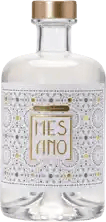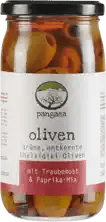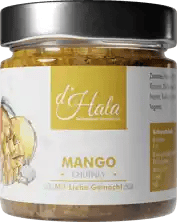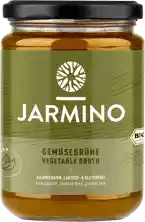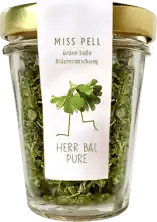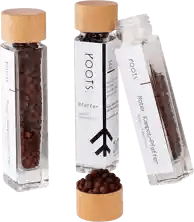Quality instead of quantity!
7,000 independent products
No mainstream
7,000 independent products
Olive oil: A gift from the Mediterranean
Olive oil is considered the liquid gold of the kitchen - but which one should you choose? From flavor profiles and health benefits to the right way to use it: Here you can find out how to make the most of olive oil's potential. And best of all: you can buy olive oils directly online.
The most important facts at a glance
Olive oil is a versatile, health-promoting and flavor-intensifying product that is available in different varieties with different intensities and for many uses.
The different types of olive oil have different flavor profiles, production methods and quality characteristics, with extra virgin olive oil and extra virgin olive oil being considered to be of particularly high quality.
Sustainability and proper storage are essential aspects in the production and handling of olive oil in order to maintain quality and protect the environment.
You can buy olive oils online directly from us. Large selection. Not mainstream.
High-quality olive oil in the kitchen
Whether hot or cold, high-quality olive oil is a real all-rounder for gourmets. It enhances the traditional flavors of salads, soups, sauces and marinades and brings out the true taste of the ingredients. No other oil can match the organoleptic complexity of olive oil.
It is no wonder that olive oils are referred to as liquid gold in Mediterranean countries. Due to its many uses and the fact that it has taken the culinary world by storm, olive oil has become an essential ingredient in every kitchen. Therefore, it is important that you choose your favorite olive oil carefully and take full advantage of the many benefits it offers.
Health benefits
Olive oils are not only a versatile culinary tool, but also a health powerhouse. As a central component of the Mediterranean diet, olive oil promotes
heart health
can have a positive effect on blood pressure
can have a positive effect on cholesterol levels
is rich in monounsaturated fatty acids, which are healthier than saturated fatty acids
can promote a better body composition
But that's not all.
The polyphenols found in olive oil, such as oleocanthal, provide antioxidant and anti-inflammatory benefits that can help protect against chronic diseases and neutralize harmful substances. In addition, olive oil can support mental health by improving cognitive function and improving mood. So it's clear that olive oil is a true friend to your well-being.
Culinary uses of olive oil
The versatility of olive oil in the kitchen is hard to beat. It is a stable oil that can be used for frying, baking and sautéing without significantly altering its health properties at temperatures below its smoke point. Due to its lower smoke point, cold-pressed olive oil is particularly suitable for quick sautéing or for seasoning hot dishes after cooking.
Mild olive oil, which is versatile, is often used in raw preparations such as salad dressings, complementing flavors such as ripe apples, bananas and herbs. But olive oil also has a firm place in patisserie. There, butter or margarine can often be replaced with extra virgin olive oil, with milder varieties such as arbequina less likely to overpower the flavors of desserts.
And for those looking to add depth of flavor to dishes such as soups, potato dishes and vegetables, intense olive oil with its bold flavor is just the ticket.
Simple starters with olive oil
Bruschetta: Toasted slices of bread topped with a mixture of diced tomatoes, fresh basil, garlic, salt, pepper and a drizzle of high-quality olive oil.
Caprese salad: Simple layers of fresh mozzarella, tomato slices and basil leaves, drizzled with olive oil and balsamic vinegar.
Greek salad: A combination of cucumber, tomatoes, red onion, feta cheese and olives, seasoned with oregano and plenty of olive oil.
Marinated olives: A mixture of green and black olives, marinated in olive oil with herbs such as rosemary and thyme, as well as garlic and lemon zest.
Hummus: Pureed chickpeas with tahini, lemon juice, garlic and olive oil, served with warm flatbread or vegetable sticks for dipping.
Simple main dishes with olive oil
Spaghetti Aglio e Olio
Spaghetti with a simple sauce of olive oil, chopped garlic, parsley and red chili flakes.Greek salad with grilled chicken
A classic Greek salad of tomatoes, cucumber, red onion, feta and olives, served with grilled chicken and a dressing of olive oil and lemon juice.Roasted vegetable platter
A selection of seasonal vegetables (such as zucchinis, peppers, eggplants), fried in olive oil and seasoned with herbs such as thyme and oregano.Ratatouille
A French dish of layered vegetables (such as tomatoes, zucchinis, eggplants) slow-cooked in olive oil.Fish fillet poached in olive oil
A tender fish fillet gently poached in olive oil and served with fresh herbs.
The different types of olive oil
Not all olive oils are the same. There are a variety of olive oils that differ in their production and properties. For example, there are
extra virgin olive oil, which is obtained by cold pressing without chemical processes
refined olive oil from lampante oil
Olive pomace oil, which is obtained from residues
EU Regulation No. 1308/2013 defines eight quality classes of olive oil, whereby high-quality olive oil has a low acidity and sensory characteristics in the form of taste and smell are important quality indicators.
The variety of olive oils allows you to find the perfect olive oil for your needs. Whether you are looking for an intensely fruity olive oil with a high polyphenol content from polyphenol-rich olive varieties such as Picual and Coratina that offers distinct sensory characteristics, or an olive oil that has won international awards for its quality and sustainable production methods.
It is important to know that mixing olive oil of different quality criteria with other vegetable oils reduces quality and can lead to consumer deception if the products are not labeled correctly.
Extra virgin olive oil
Extra virgin olive oil is the first quality class among olive oils. It is obtained exclusively by mechanical means from the fruit of the olive tree and is subject to strict chemical-physical and organoleptic minimum quality standards laid down in European legislation. The production of extra virgin olive oil is a meticulous process. The olives are carefully harvested by hand and pressed on the day of harvest to prevent oxidation.
The taste of extra virgin olive oil varies from light to intensely fruity and always with a bitter note. It is known for its lowest levels of harmful compounds when heated, making it one of the most stable oils for cooking. And, of course, sustainability also plays an important role. The high quality of extra virgin olive oil is emphasized by organic certifications and the organic harvesting of olives, as these indicate sustainable production without pesticides and insecticides.
Cold-pressed olive oil
Cold-pressed olive oil is another star among olive oils. It is obtained by mechanical processes at room temperature without chemical solvents. The cold pressing process typically takes 24 hours and helps to produce a higher quality olive oil than other production methods. The quality of cold-pressed olive oil is determined by the temperature during the extraction process, which must not exceed 27 degrees.
Although extra virgin olive oil is more expensive than refined oils due to lower yields, more labor and preservation of valuable ingredients, it is worth the price. A good cold-pressed olive oil should have an intense, slightly tart aroma and not smell like spoiled oil. It also contains polyphenols, which have heart-protective properties.
Regional characteristics of olive oils
Olive oils are as diverse as the countries and regions in which they are produced. Italy, Spain and Greece offer a variety of unique olive oils that differ in their individual flavor profiles and characteristics.
Italy has over 500 different olive varieties, resulting in a wide range of flavor profiles.
Spain is known for its distinctive olive varieties that shape the flavor profile of the global olive oil market.
Greece has many growing regions, resulting in a wide range of flavor profiles.
So there is always something new to discover when it comes to olive oil.
Whether you are a fan of monocultivar olive oils from Italy, which are made from a single olive variety such as Taggiasca or Leccino and highlight the uniqueness of regional flavors, or whether you prefer the distinctive flavor profiles of olive oils from Spain and Greece, the choice is diverse. It is the joy of discovery and experimentation that makes the world of olive oils so fascinating!
Italian olive oil
Italy is not only known for its pasta and pizza, but also for its olive oil. With over 538 types of olive trees (cultivars), Italy offers an almost infinite variety of olive oils. Every region, every province, even every hill has its own olive variety and its own olive oil. And each of these oils has its own unique flavor profile.
Spanish olive oil
As the world's largest olive oil producer, Spain shapes the flavor profile of the global olive oil market. Spain produces a variety of olive oils that are characterized by unique regional characteristics. Each region has its own olive varieties and produces olive oils with unique flavor profiles.
Greek olive oil
Greece, the cradle of Western civilization, is also home to a variety of unique olive oils. Greek olive oils are particularly known for their fruity taste experience, which is shaped by the country's specific climatic and geographical conditions.
Whether it's the mildly sweet olive oil from Lesbos or the fruity and spicy olive oil from Sitia on Crete, the variety of flavors in Greek olive oils is impressive.
Storing olive oil correctly
Storing olive oil correctly is crucial to preserving its quality and taste. Olive oil should be stored away from direct sunlight to avoid oxidation and changes in taste. Storage in a dark glass bottle or in a stainless steel container can preserve the quality of the olive oil better than in clear bottles.
Olive oil should not be stored next to heat sources such as ovens or heaters, as heat can accelerate ageing. The ideal storage temperature for olive oil is between ten and 16 degrees Celsius. It is important that your bottle or canister of olive oil is well sealed so that no components react with oxygen and affect the quality. And remember that properly stored virgin olive oil can be kept for up to two years.
Sustainability and olive oil production
Sustainability is playing an increasingly important role in olive oil production. The cornerstones of the sustainability concept in olive oil production are economy, ecology and social responsibility. Sustainable olive oil production includes fair working conditions, fair trade, promotion of local communities and industry-wide cooperation to improve quality.
Sustainable practices include:
Harvesting olives by the day to protect nesting birds in the olive trees and preserve the biodiversity of the region.
Producers of high-quality and sustainable olive oils voluntarily have their products tested for mineral oil and plastic contamination to guarantee a product that is safe for human health.
Cold pressing is an environmentally friendly production method that is more sustainable than chemical extraction with solvents, but requires more time.
Olive oil as a gift idea
Looking for the perfect gift? How about an olive oil gift set? Olive oil gift sets are versatile and suitable for numerous occasions such as Christmas, birthdays or company celebrations. Whether you are looking for a gift for a culinary connoisseur, a health-conscious friend or just someone who appreciates something special, an olive oil gift set is always a good choice.
Gift sets can include selected combinations such as a bottle of olive oil with green olives, basil and a nougat bar. The packaging of the gift sets can be reminiscent of a perfume, for example, and often becomes a design object thanks to creative labels or original bottle shapes. And for those who are looking for something special, there are high-quality gift options that contain multi-award-winning extra virgin olive oil presented in an elegantly designed gift box.
Buy olive oil at Honest & Rare
At Honest & Rare you will find a carefully curated selection of high-quality olive oils. We are your marketplace for exceptional drinks and food. Away from the mainstream, we offer you rare and handmade products online that are not available in every supermarket. Simply add your desired products to the shopping cart and order from the comfort of your own home. For more information or questions about delivery, you can contact us by email.
Whether you're looking for a mild olive oil for your salads, a medium olive oil for cooking or an intense olive oil to drizzle over your dishes, you'll find exactly what you're looking for here. And the best thing about it? You can order your favorite olive oil from the comfort of your own home and have it delivered straight to your door.
Olive oil: frequently asked questions & answers
What should you look out for with olive oil?
When buying olive oil, you should make sure that it is labeled "extra virgin olive oil", cold-pressed and free from chemical additives. It should smell fresh and have green vegetable notes, and the color can vary. An acidity of less than 0.8 percent is a sign of the highest quality.
Is olive oil really that healthy?
Olive oil, especially intensely green, bitter and scratchy tasting varieties, is healthy due to its high content of polyphenols and can prevent various diseases, especially of the cardiovascular system. The favorable fatty acid composition also helps to lower harmful LDL cholesterol.
Why shouldn't olive oil be heated too much?
It is advisable not to heat olive oil excessively, as it has a relatively low smoke point. If the oil exceeds this point, it not only begins to smoke, but the valuable health-promoting ingredients are also broken down and potentially harmful substances can be released. For this reason, olive oil should preferably be used at low to medium heat zones, while oils with a higher smoke point should be used for cooking at high temperatures.
Does the color of the olive oil come from the color of the olives?
The nuances of olive oil color are actually a reflection of the degree of ripeness of the olives used. Green olives that are not yet fully ripe give the oil a greenish color and bring with them a stronger, sharper flavor. In contrast, olive oil made from fully ripened black olives tends to have a more golden color and a softer flavor profile. However, processing and filtration methods can also influence the final color of the olive oil.
Brilliant!

Bitte bestätige deine Anmeldung noch eben - du hast eine Bestätigungsmail von uns. Klicke darin auf den Link. Danach bekommst du deinen Rabattgutschein.




















